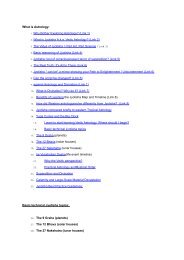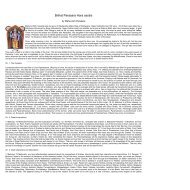Yantra Yantra Should Be Frequently Energized With The
Yantra Yantra Should Be Frequently Energized With The
Yantra Yantra Should Be Frequently Energized With The
Create successful ePaper yourself
Turn your PDF publications into a flip-book with our unique Google optimized e-Paper software.
elaxed. To come out of<br />
the pose, first lift your<br />
head and place it<br />
gently back down, then<br />
release the arms.<br />
spine.<br />
3. Continue right<br />
down and hold on to<br />
whichever part of<br />
your legs or feet you<br />
can comfortably<br />
reach without<br />
bending the knees.<br />
<strong>With</strong> practice, you<br />
can wrap your index<br />
fingers around your<br />
big toes and bring<br />
your elbows down to<br />
to the floor, or<br />
stretch your arms out<br />
over your feet, as<br />
shown right.<br />
In the position, breathe deeply, feeling<br />
yourself and advancing forward a little<br />
more every time you exhale. Hold for three<br />
or four deep breaths at first, gradually<br />
increasing the number as you become<br />
relaxed in the pose. When you release the<br />
position, reach forward as you come up.<br />
THE COBRA (BHUJANGASANA) :<br />
THE LOCUST (SALABHASANA):<br />
In Bhujangasana, the head and trunk arch<br />
gracefully up, like a corba with its hood raised.<br />
<strong>The</strong> spine receives a powerful backward stretch,<br />
the surrounding musculature is strengthened and<br />
the abdominal organs are toned up and massaged.<br />
<strong>The</strong> pose is particularly effective for combating<br />
menstrual irregularities and pain and relieving<br />
constipation. Perform the asana in stages, as shown<br />
below, visualizing the smooth, supple movement<br />
of a snake as you slowly stretch your spine up and<br />
backward, vertebra by vertebra. Keep your<br />
shoulders down, your elbows tucked in to your<br />
body, and your face relaxed in the pose. You may<br />
find the full Cobra position difficult to achieve at<br />
first, but in time your spine will become supple<br />
Unlike most asanas, the Locust or Salabhasana<br />
requires a sudden movement to get into the<br />
pose. Its effects supplement those of the Cobra<br />
but where the Cobra concentrates on the upper<br />
half of the body, the Locust works mainly on the<br />
lower half, strengthening the abdomen, lower<br />
backs and legs. Like the other backward bends,<br />
it manages the internal organs, ensuring<br />
efficient functioning of the digestive system and<br />
preventing constipation. To begin with, you<br />
may only manage to raise your legs a few inches<br />
off the floor - in fact, it is at this stage that the<br />
pose most resembles a locust, tall in air. <strong>With</strong><br />
regular practice you will discover how to




